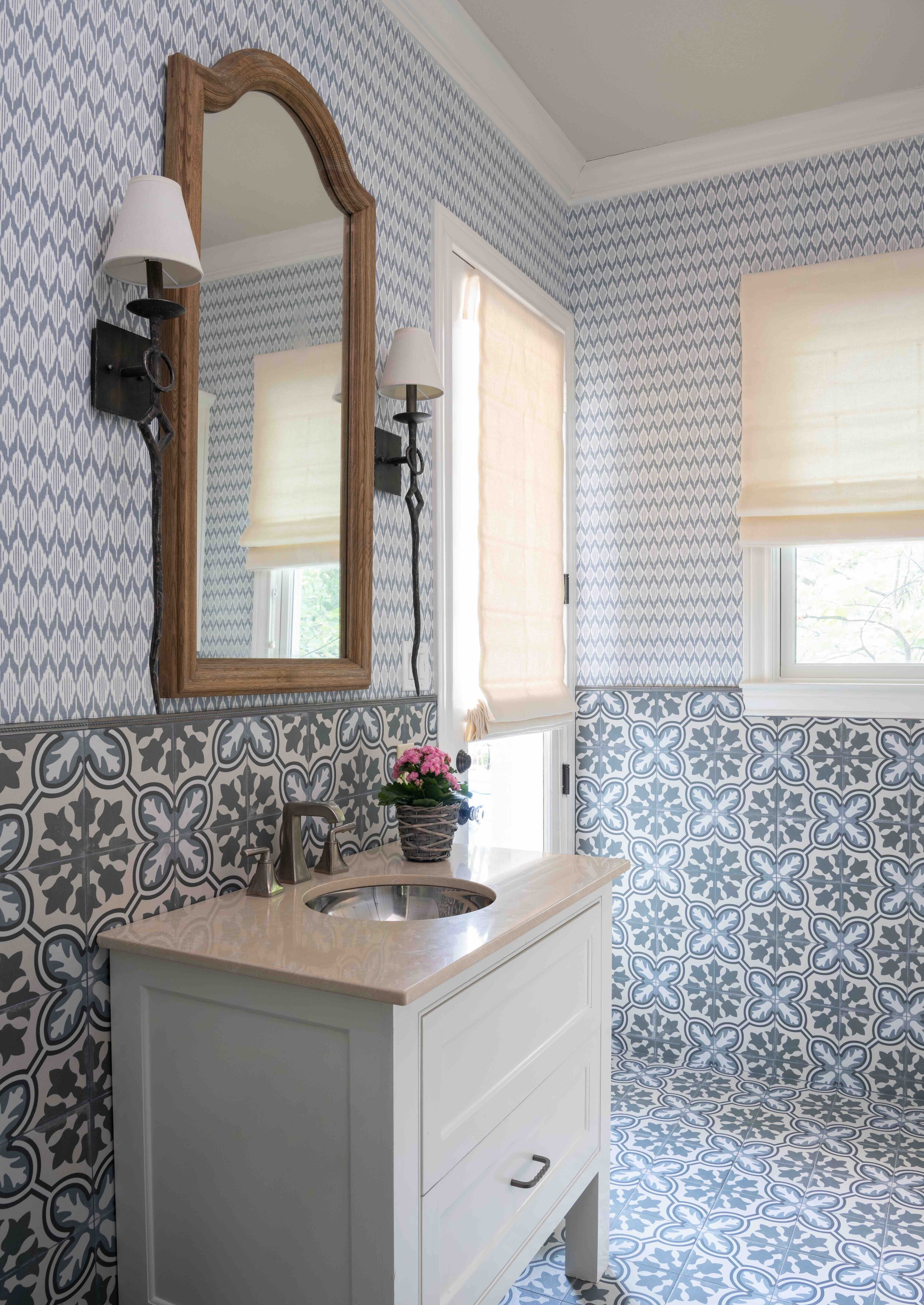Patterned tiles, like the ones we used in this Preston Hollow pool bathroom, can add a lot of impact to a small space.
One of the reasons choosing tiles for your bathroom can be so tricky is that there are a lot of options, but not all of them will still look current in a few years. And, unfortunately, swapping out tile is not an easy project. The key is to find the right balance between a tile that is timeless but also has some character to it. The most important factors to consider are: the size of your bathroom, your preferred colors, and what pattern you want the tiles to be installed in.
Tile Sizes:
Different parts of your bathroom call for different sizes of tiles. For example, if you have a shower bench, a larger slab will feel more comfortable to sit on than a lot of smaller tiles. At my design firm, we usually use matching slabs of the same material for both the shower seat and the sink countertop.
This shower we remodeled in a Colleyville home has small mosaic tiles on the floor for safety and security.
Mosaic tile has more grout lines, which makes it suitable for shower floors: more grout lines equal better drainage and more traction. Ideally, the tiles should be two inches or smaller. Mosaic tiles are not the only choice for shower floors, however. Slip-resistant ceramic is another safe option.
Tile Colors:
The most popular tile for bathrooms is white subway tile. I recommend choosing a bright white tile if your toilet, bathtub, and sink are also bright white. Sometimes, a warmer white (such as a biscuit color) is preferable, especially in traditional houses.
I personally consider bold accent tiles to be dated. I haven’t used them in my projects for a decade. Instead of having a border of accent tiles in your bathroom, I suggest combining a neutral tile (like white or gray) with an interesting wallpaper or paint color.
These floor tiles are cut in a fresh new version of a traditional pattern. The biscuit white color matches the tub.
Remember the rule of three: a patterned tile should contain no more than three colors, and you should stick to no more than three varieties of tile in the entire bathroom. A good starting point is to pick out a tile you really love and then pick two other tile types that complement it.
Something to note about dark grout is that it shows efflorescence (light grey spots from salts) over time. White grout will show dirt more easily, so make sure to use grout sealer and thin grout lines if you choose white for your grout color.
Tile Materials:
Ceramic is the most affordable tile, so it’s a good choice for covering large areas such as your floor. Porcelain is more expensive, but many people prefer it for the following reasons: it’s more durable, and the color goes all the way through the tile instead of being merely glazed on top. That way, if a porcelain tile is chipped, the color that shows underneath is the same.
Glass tile is great for an accent wall, but it’s also slippery, so don’t use it on the floor. If you’re interested in glass tile, try shopping for it in person instead of online. Seeing it in person helps you get a better sense of its color and shine.
Tile Placement and Patterns:
Tile should be used on every side of the shower except for the door or curtain. I like to encourage my clients to also cover the shower ceiling with tile instead of paint, since paint can peel in humidity.
A common piece of advice is to install floor tiles diagonally to makes a small bathroom feel more expansive. Just keep in mind that attention-grabbing patterns like diagonal and herringbone should only be used with simple tile patterns that have subtle grout lines. The most conservative patterns for tile are “running bond” (which looks like an alternating brick pattern) and “stacked,” in which rows of tiles are stacked vertically from top to bottom.
This floor has small hexagon-shaped tiles that run into the shower, while the shower walls have herringbone tiles.
The right tile choices can make or break a bathroom, so it’s worth your time to research and proceed with caution. After all, it’s a costly mistake to pick the wrong tile. If you’re hesitating between several different options, then it might be time to consult a professional designer. An experienced designer like myself will be able to point you towards options that are both practical and pleasing to the eye. To schedule a consultation with us, send an email to info@chambersinteriors.com or call our Dallas office at 214-651-7665.




